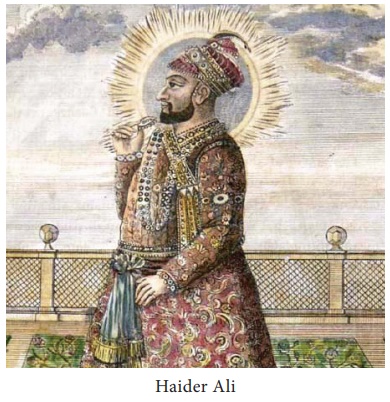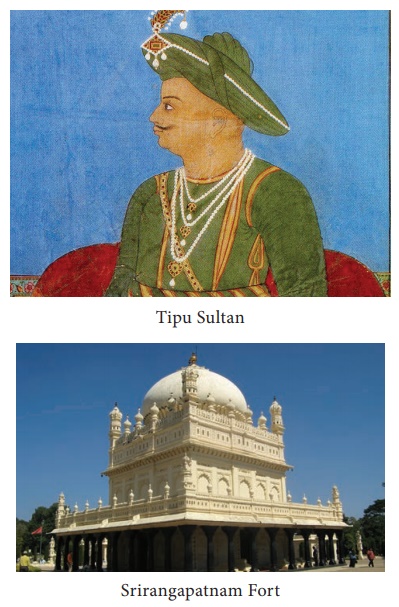Early Resistance to British Rule - Mysore Sultans and their Resistance | 11th History : Chapter 18 : Early Resistance to British Rule
Chapter: 11th History : Chapter 18 : Early Resistance to British Rule
Mysore Sultans and their Resistance
Mysore Sultans and their Resistance
Rise of Haider Ali
Mysore was a small feudatory kingdom under the
Vijayanagar Empire. After Vijayanagar fell in 1565, the ruling dynasty of
Wodeyars asserted their independence and the Raja Wodeyar ascended the throne
in 1578. The capital moved from Mysore to Srirangapatnam in 1610. Wodeyar
dynasty continued to reign until 1760, when the real power changed hands to
Haider Ali who was appointed Dalwai or prime minister.

Haider’s father Fateh Muhammad was the Faujdar
(garrison commander) of Kolar. After his death Haider’s soldierly qualities
helped him to rise through the military ranks. By 1755 he had secured a
powerful position, commanding 100 horsemen and 2000 infantry men. Haider
suppressed an army mutiny in Mysore and restored the places of the Mysore
kingdom occupied by Marathas. He received the title of “Fateh Haider Bahadur”
or “the brave and victorious Lion”. In 1760 Haider allied himself with the
French at Pondicherry against the English, but his position at home was
endangered by the plot engineered by the Marathas. As Haider successfully
handled the situation and thereafter he became not only Dalawai but the de
facto ruler of Mysore. In 1770 the Mysore king Nanjaraja was poisoned to death
and Haider’s hand was suspected. Thereafter Wodeyar kings functioned only as
nominal rulers. The real royal authority vested in Haider.
Haider Ali and the British
After obtaining Diwani right (right to collect
taxes on behalf of the Mughal emperor from Bengal, Bihar and Orissa), the
Company had to safeguard its territories. As the Company was not strong enough,
it avoided interfering in the internal affairs of the Indian states. Warren
Hastings maintained buffer states to live within a “Ring Fence”. The Company
was, however, drawn towards the affairs of the Carnatic, due to the successive
struggles for its Nawabship. The English traders saw in this a great
opportunity to directly interfere in Indian politics. However, there were
threats from two strong powers represented by Haider Ali and the Nizam of
Hyderabad.
First Mysore War (1767-69)
In the third Carnatic War Colonel Forde while
conducting the forces from Bengal captured Masulipatnam in 1759. This led to a
treaty with Salabad Jung, who ceded the Northern Sarkars to the British
(districts of Ganjam, Vizagapatnam, Godavari, Krishna and Guntur) . English
acquisition of the Northern Sarkars was legalized by the Mughal emperor in 1765
by the treaty of Allahabad. In 1766, trouble arose when the English occupied
those districts. Yet a treaty was signed with Nizam Ali who acquiesced in the
session. In return the English promised to help out in case of any danger from
the enemies. This promise meant English help to the Nizam against Haider Ali.
Here lay the genesis of the later Subsidiary System. Despite the treaty, Nizam
came to an understanding with Haider in 1767 and the British therefore declared
a war against Haider. This is called First Anglo-Mysore War or First Mysore
War.
An English army from Bombay captured Mangalore and
other surrounding places on the West Coast. But Haider succeeded in recovering
both. The English made an attempt to capture Bangalore but to no avail. In 1768
Haider pounced on Baramahal (Salem district) and marched on Karur and then
Erode and took over both by defeating Captain Nixon. Meanwhile, his general
Fazalullah Khan marched on Madurai and Tirunelveli. Haider advanced to
Thanjavur and from there to Cuddalore. Though Haider did not want stop his
offensive against the English, the threat of Maratha invasion forced him to
negotiate peace with the English. The terms of Treaty of Madras were as
follows: the conquered territories to be restored to each, excepting Karur
which was to be retained by Haider. Mutual assistance was to be rendered in
wars of defence. This meant the English were under obligation to help Haider
against the Marathas. But when assistance from English was not forthcoming,
Haider turned against the English.
Haider and the Second Mysore War (1780)
After the American War of Independence, France had
signed a treaty of friendship with America (1778) and so Britain declared war
against France. In a similar context of Spain reaching an agreement with
America, and thereby being dragged into the war against England (1779) England
remained isolated. In India the coming together of the Nizam and the Marathas,
supported by the French aggravated the situation further. Haider Ali wanted to
turn England’s difficulty to its advantage and marched on Karnataka.
Colonel Baillie, who was to join the force led by
Hector Munro, was badly wounded in a sudden attack by Haider. This forced Munro
to move Madras. Haider captured Arcot (1780). Now on request from Madras
government Sir Eyre Coote, the victor of the Battle of Wandawashi, was sent
from Calcutta to besiege Madras by sea. Having scored a victory against Haider,
Coote proceeded to Pondicherry. Haider in the meantime overran the kingdom of
Thanjavur. Coote reached Porto Novo and won a decisive victory over Haider.
Haider narrowly escaped capture. Colonel Braithwaite was thoroughly defeated
near Kumbakonam by Haider’s son Tipu and taken prisoner. In order to divert the
attention of the Mysore Sultan, an expedition was undertaken by General Mathews
to capture Mangalore. Expectedly Tipu abandoned Karnataka and moved to West
Coast.
The death of Haider due to cancer in 1782, the
signing of Treaty of Paris (1783) at the end of American War of Independence,
and the protracted siege of Mangalore enabled the English to be aggressive against
Tipu. Karur and Dindigul were captured by Colonel Lang, Colonel Fullerton
seized Palghat and Coimbatore but this advance on Srirangapatnam was pre-empted
by Tipu with his proposal for peace. The Treaty of Mangalore was signed in
March 1784, according to which both parties agreed to give up their conquests
and release the prisoners.
Third Mysore War (1790-92)
In the meantime Lord Cornwallis had become governor
general. Cornwallis wanted to deal with Tipu in a revengeful manner. The two
great southern powers, the Nizam of Hyderabad and the Maratha confederacy,
supported the British as its allies. The Nizam of Hyderabad supplied resources
and even troops for the British. The Marathas, who had signed the Treaty of
Salbai with the English after the First Anglo-Maratha war in 1782, also joined
the British. The British position was thus greatly strengthened.
Tipu sent an embassy to Constantinople and another
in 1787 to Paris. These diplomatic efforts of Tipu were intended to strengthen
him against the English. The French Monarch Louis XVI was hospitable, but could
give only vague promises of support to the Sultan.
Tipu’s attack on Travancore which was an ally of
the British and his capture of Cranganore was treated as a declaration of war
on the Company government. Hence the third Anglo-Mysore War broke out.

Colonel Hartley defeated Tipu’s general Husain Ali
at Calicut. In response Tipu captured Tiruvannamalai. His effort to get the
support of French Pondicherry Governor did not materialise. Cornwallis himself
marched from Vellore and reached Bangalore. On his way he encountered Tipu and
defeated him near Srirangapatnam. But lack of provisions compelled Cornwallis
to retreat. At this juncture the Marathas helped the British in supplying the
required provisions. The reinforced army of the English marched on
Srirangapatnam again and besieged it. Unable to withstand the onslaught of the
British forces Tipu offered peace and accepted the terms imposed by Cornwallis.
According to the treaty of Srirangapatnam, the Tipu
was to give up half of his dominions, pay three crores of rupees as indemnity,
and pledge two of his sons as hostages. The allies were given equal shares of
the indemnity and of the ceded territories. The English got Malabar, Dindigul
and Barmahal. Tipu lost Coorg (Kudagu), whose raja became a feudatory to the
Company. Tipu’s power was greatly reduced. And after their stay at Madras as
hostages the boys returned to Srirangapatnam on 29 May 1794 when their father
had paid all the dues to the English. Tipu could hardly forget his humiliation
and the heavy territorial and monetary losses suffered.
The Mysore king Chamaraj IX died in 1796. Tipu
resolved not to observe the formality of appointing a king. Synchronizing with
this resolve came the announcement of the French colonial Governor of Mauritius
General Malartic that, after obtaining French help, he would declare war on the
English. In July 1798 Tipu’s correspondence with the French Directory and later
with Napoleon and his evasiveness in his correspondence with Wellesley led to
his declaration of war against Tipu.
Fourth Mysore War (1799)
Tipu made all out efforts to strengthen his
military and financial resources. In 1796 Tipu sent emissaries to Paris again.
In 1797 he received a French emissary to confirm French support from Mauritius.
A Jacobin club was started in Srirangapatinam and the flag of the French
Republic was hoisted to mark the cordiality established between the French and
the Sultan of Mysore.
Irked by Tipu’s alliance with the French Wellesley,
now the new Governor General, insisted on a standing army at Mysore under the
Subsidiary System. Tipu turned down Wellesley’s proposal and the British
declared the fourth Anglo -Mysore war in 1799. General David Baird stormed Srirangapatnam.
Tipu’s offer of peace was rejected and in the eventual battle Tipu was wounded
and soon after shot dead by a European Soldier.
The elimination of Tipu and the restoration of the old Wodeyar dynasty to the Mysore kingdom marked the real beginning of Company rule in south India. The sons of the slain Tipu were interned first at Vellore, and later, after the Vellore Revolt of 1806, shifted to Calcutta. Thus ended the valiant fight of Mysore Sultans against the British.
Related Topics